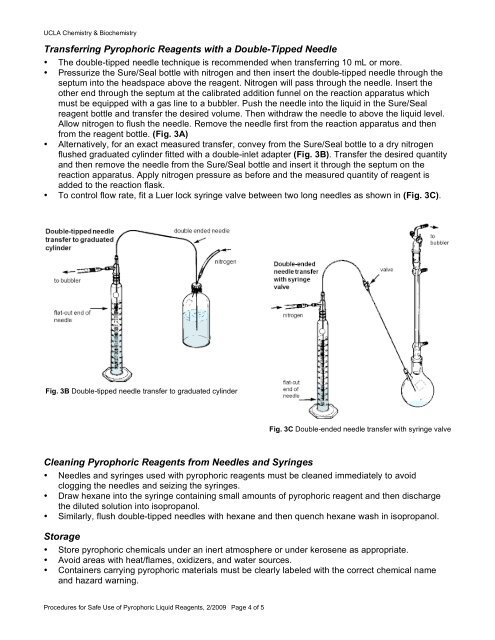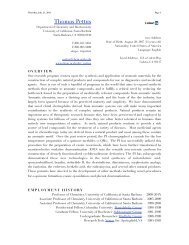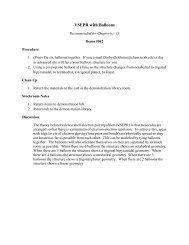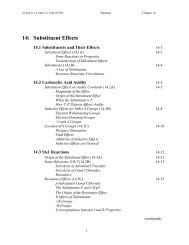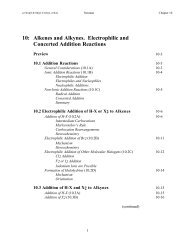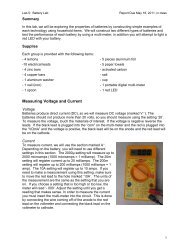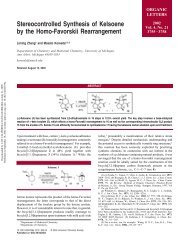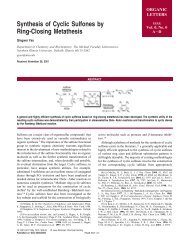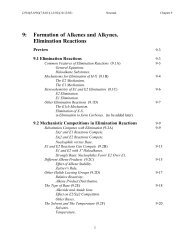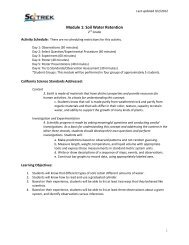Pyrophoric Liquid Reagents - UCLA Chemistry and Biochemistry
Pyrophoric Liquid Reagents - UCLA Chemistry and Biochemistry
Pyrophoric Liquid Reagents - UCLA Chemistry and Biochemistry
Create successful ePaper yourself
Turn your PDF publications into a flip-book with our unique Google optimized e-Paper software.
<strong>UCLA</strong> <strong>Chemistry</strong> & <strong>Biochemistry</strong><br />
Transferring <strong>Pyrophoric</strong> <strong>Reagents</strong> with a Double-Tipped Needle<br />
• The double-tipped needle technique is recommended when transferring 10 mL or more.<br />
• Pressurize the Sure/Seal bottle with nitrogen <strong>and</strong> then insert the double-tipped needle through the<br />
septum into the headspace above the reagent. Nitrogen will pass through the needle. Insert the<br />
other end through the septum at the calibrated addition funnel on the reaction apparatus which<br />
must be equipped with a gas line to a bubbler. Push the needle into the liquid in the Sure/Seal<br />
reagent bottle <strong>and</strong> transfer the desired volume. Then withdraw the needle to above the liquid level.<br />
Allow nitrogen to flush the needle. Remove the needle first from the reaction apparatus <strong>and</strong> then<br />
from the reagent bottle. (Fig. 3A)<br />
• Alternatively, for an exact measured transfer, convey from the Sure/Seal bottle to a dry nitrogen<br />
flushed graduated cylinder fitted with a double-inlet adapter (Fig. 3B). Transfer the desired quantity<br />
<strong>and</strong> then remove the needle from the Sure/Seal bottle <strong>and</strong> insert it through the septum on the<br />
reaction apparatus. Apply nitrogen pressure as before <strong>and</strong> the measured quantity of reagent is<br />
added to the reaction flask.<br />
• To control flow rate, fit a Luer lock syringe valve between two long needles as shown in (Fig. 3C).<br />
Fig. 3B Double-tipped needle transfer to graduated cylinder<br />
Fig. 3C Double-ended needle transfer with syringe valve<br />
Cleaning <strong>Pyrophoric</strong> <strong>Reagents</strong> from Needles <strong>and</strong> Syringes<br />
• Needles <strong>and</strong> syringes used with pyrophoric reagents must be cleaned immediately to avoid<br />
clogging the needles <strong>and</strong> seizing the syringes.<br />
• Draw hexane into the syringe containing small amounts of pyrophoric reagent <strong>and</strong> then discharge<br />
the diluted solution into isopropanol.<br />
• Similarly, flush double-tipped needles with hexane <strong>and</strong> then quench hexane wash in isopropanol.<br />
Storage<br />
• Store pyrophoric chemicals under an inert atmosphere or under kerosene as appropriate.<br />
• Avoid areas with heat/flames, oxidizers, <strong>and</strong> water sources.<br />
• Containers carrying pyrophoric materials must be clearly labeled with the correct chemical name<br />
<strong>and</strong> hazard warning.<br />
Procedures for Safe Use of <strong>Pyrophoric</strong> <strong>Liquid</strong> <strong>Reagents</strong>, 2/2009 Page 4 of 5


